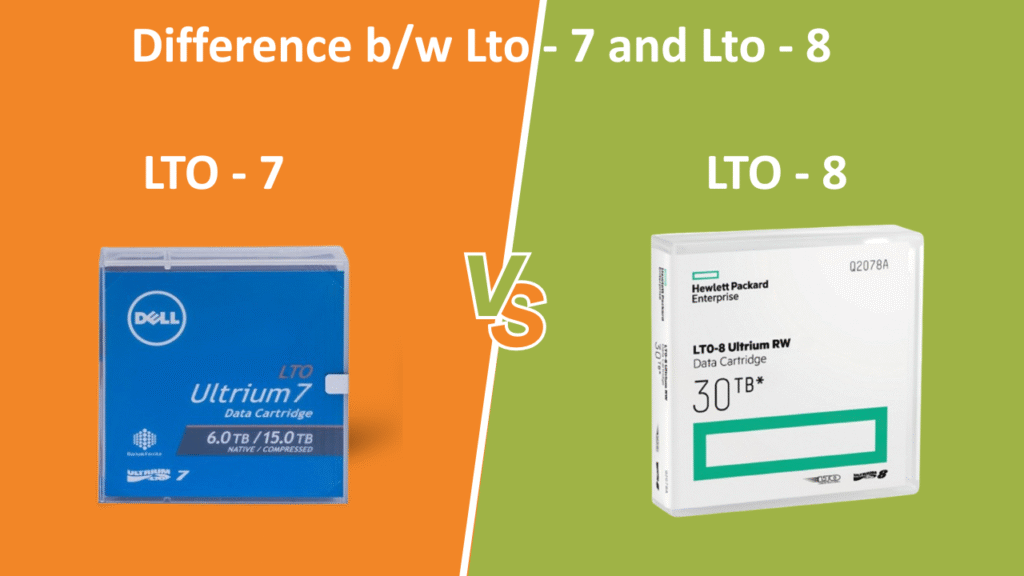Data backup and data storage are imperative to all businesses today. As the digital information expands, there should be reliable and high-capacity storage solutions as never before. Linear Tape-Open, abbreviated as LTO, has been a reliable solution for those companies requiring long-term archiving. LTO has been improved into several generations over the years. In the last few years, LTO-7 and LTO-8 have been two of the trends. Both are strong; however, they vary in capacity, speed, and compatibility.
In this blog, we are going to discuss key differences between LTO-7 and LTO-8 and assist you in knowing which type of LTO can suit your needs.
What is LTO?
LTO is an acronym of Linear Tape-Open. It is a magnetic tape storage medium that was invented for high-capacity data storage and backup. LTO tapes are effective business archiving tools since they are affordable, dependable, and safe. The subsequent generation of LTO has a higher storage capacity and improved performance levels than the former.
Capacity Differences
Storage capacity is the most evident difference between LTO-7 and LTO-8.
- LTO-7 has a native capacity of approximately 6 TB. It is capable of holding 15 TB with compression.
- LTO-8 doubles this capacity. It has 12 TB (non-compressed) and a maximum of 30 TB (compressed).
This implies that in the case of huge data sets, LTO-8 will enable you to capture more data in fewer cartridges. That saves space, lowers the quantity of tapes, and simplifies management.
Speed and Performance
It is not just a case of capacity. Another important element here is the performance that is required when backing up or restoring huge amounts of data.
- LTO-7 presents a native data transfer speed of approximately 300 MB/sec. With compression, under 750 MB per second is the possible speed.
- LTO-8 has even improved performance. It has a native bandwidth of 360 MB every second, and with compression, it can also achieve approximately 900 MB every second.
This translates to the fact that LTO-8 is capable of backup and recovery at an increased rate that is critical when there is a need to reduce downtime.
LTO-7 vs LTO-8: A Quick Comparison
| Feature | LTO-7 | LTO-8 |
|---|---|---|
| Native Capacity | 6 TB | 12 TB |
| Compressed Capacity | Up to 15 TB | Up to 30 TB |
| Native Speed | 300 MB/s | 360 MB/s |
| Compressed Speed | Up to 750 MB/s | Up to 900 MB/s |
| Media Reliability | Strong, standard | Improved durability |
| Compatibility | Reads/Writes LTO-7 | Reads/Writes LTO-7 & LTO-8, supports Type M |
Media Improvements
The purpose of the LTO tapes is durability and long-term storage. LTO-8 enhances the safety in terms of media quality and error correction. These upgrades allow the data that was stored over the years to be safe and available.
LTO-8 has an advantage for businesses with a solid requirement for long-term archiving without the need to change the tape very frequently.
Compatibility and Type M Tapes
Compatibility is one such difference.
- LTO-7 drives can read and write LTO-7 tapes. Reading older tapes is also dependent on the model.
- LTO-8 drives are also more adaptable. They can read and write LTO-8 media. They also work with LTO-7 tapes.
A notable thing about the LTO-8 drives is the Type M tapes. A tape with LTO-7 format can be written as a Type M tape. The formatted version comes with roughly 9 TB of native memory rather than 6 TB, once formatted. But this Type M tape is only compatible with the LTO-8 drives. It does not support LTO-7 drives.
This characteristic assists businesses in making use of the existing tapes of LTO-7 and having a higher capacity.
Cost Considerations
The issue of cost is significant in deciding between LTO-7 and LTO-8.
- LTO-7 cartridges tend to be less expensive. In the case of moderate storage requirements, it might be a good value.
- LTO-8 cartridges are costlier and usually charge less per terabyte when it comes to the high capacity.
Hardware is another aspect to be considered. You are going to require an LTO-8 drive to use LTO-8 tapes. If you already have the use of LTO-7 drives in your business, you will have to invest more while upgrading.
Which One Should You Choose?
Choosing between LTO-7 and LTO-8 depends on your business needs.
Pick LTO-7 if:
- You already own LTO-7 hardware.
- The needs of your data storage are at a middle level.
- You desire something cheaper.
Pick LTO-8 if:
- You expect rapid data growth.
- You are interested in quicker backups and restores.
- You need higher reliability for long-term archiving.
- You are willing to spend on new hardware.
Conclusion
LTO-7 and LTO-8 are both good tape storage methods. LTO-7 has good performance and reliability at a lower cost. LTO-8 will be twice the storage capacity in the storage system, faster, and more flexible with Type M tapes.
LTO-8 is a more intelligent choice for the future if you require high-memory storage capacities and performance. If the needs are modest and you wish to save money, LTO-7 will prove useful.
Finally, the correct one will be dependent on how you are currently structured and where you are planning to grow. Tape storage is one of the most stable and affordable options, as both generations present a good option in securing data over a longer time.
